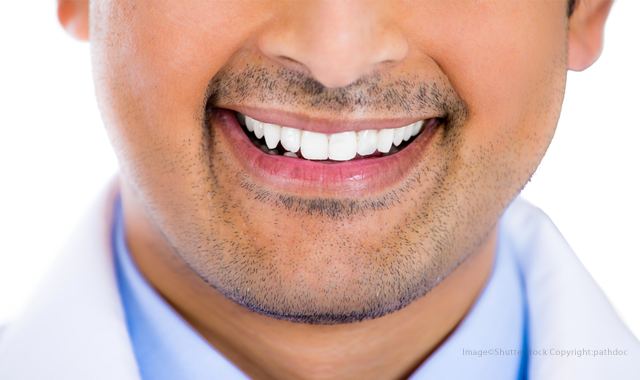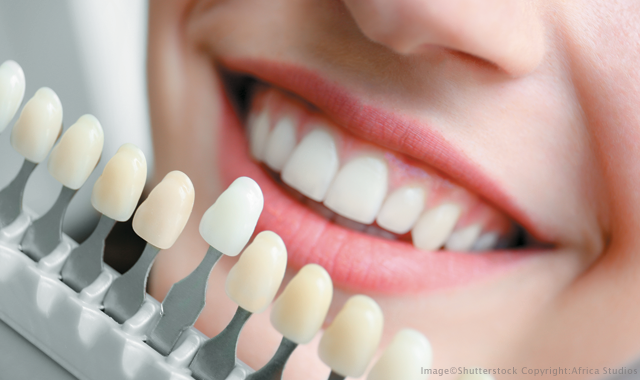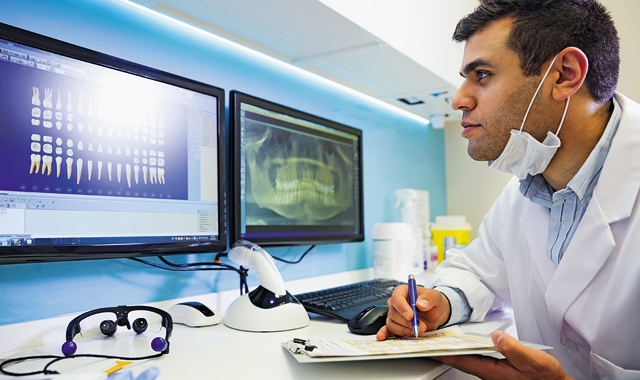The evolution of cosmetic dentistry
Each decade brings new advancements to the profession, requiring dentists to keep up with the times.
Cosmetic dentistry has evolved throughout its existence. Etruscans and Romans dabbled in implants, bridges, and teeth whitening, but it wasn’t until the late 20th century that cosmetic dentistry became its own field. Since then, the advancements have been substantial.

“Cosmetic dentistry has always been around, and people have always seen teeth as something to enhance their appearance,” says John Rowe, DDS, AAACD. “Prior to organized dentistry, different cultures would use different enhancements. The Mayans would use jade inlays, and tooth sharpening or filing was practiced in various cultures worldwide.”
Cosmetic dentistry has come a long way. For Hollywood actors in the 1930s, decades before bonding was invented, creating the perfect smile essentially depended on dentures. Thanks to resin and porcelain bonding, veneers now take center stage.
With each decade, the changes to the profession are multiplied. Dentists practicing now have had to forget certain procedures they learned in dental school - procedures that haven’t kept up with the times.
Trending article: The top 10 worst states to be a dentist
“Almost every single procedure I learned in dental school I don’t do anymore,” says Tanya L. DeSanto, DDS, FICD. “Our profession has evolved that much in the last 30 years.”
“Cosmetic dentistry as we know it today is probably best represented by veneers,” Dr. Rowe adds. “When pioneers like Buonocore and Calamia taught dentists how to bond resin and porcelain to enamel and dentin, things got a lot more predictable and functional for a relatively permanent fix.”
How exactly has cosmetic dentistry changed in recent history?
Click through the slides to find out.


1. Techniques are more standardized
The process of creating a new smile is now associated with certain accepted parameters, says Fred H. Peck, DDS, AAACD.
“Consider direct resin bonding,” he says. “There are slight differences in techniques, but we all have the same basic premise of how we teach somebody who’s never done it. In the past, it wasn’t out there. It was hard to find many dentists who were actually teaching these techniques, but now it’s more mainstream.”
More from the author: Using Smile Lite MDP to take quality photos
Dr. Peck says it’s about the macro-esthetic components such as getting the smile design correct. The second aspect is then designing the color and shape of the porcelain, which can either be done by the laboratory technician or by the dentist. In the latter case, it’s accomplished with direct resin following accepted modalities of treatment, he says.



2. Materials have improved
When Dr. Peck started practicing 30 years ago, he says there were only a few ways to whiten teeth or place crowns - and they weren’t great.
Times have changed in the last 10 to 15 years. Today’s materials are stronger and more esthetic, and that strength makes a huge difference in patient care. Dentists can now be more conservative with tooth removal.
“In the past, we used mostly feldspathic porcelain and lucite glass ceramics, which were 120 to 200 MPa in strength,” says John F. Weston DDS, FAACD. “Now, we’ve got lithium disilicate and zirconia materials that are up to five times the strength with very thin applications.”
Related reading: 4 easy ways to get into cosmetic dentistry
Another important shift, thanks to improvements in direct materials, is the introduction of nanotechnology to the field. “Now, we have strength and high polishability in one layer,” Dr. Weston says.
“You have function paired with outstanding esthetics in 2018,” DeSanto adds. “The science has evolved to the point where we can make beautiful restorations that are lifelike and strong.”
DeSanto compares today’s materials to the amalgams and gold restorations that she worked with as a student more than 20 years ago.
“The research has taken us light years ahead. It’s not even the same profession that it once was,” she says.



3. Patient-driven care is more common
Perhaps not surprisingly, patients are more interested in cosmetic dentistry than ever before. In fact, the level of patient interest is so high that they’ve had a significant role in pushing cosmetic dentistry forward.
Patient interest in cosmetic dentistry is thanks in part to social media and the need to Facetune thousands of selfies.
“Because of social media, patients are very aware of what options are available to them and they know what they want to look like when the treatment is completed,” says Sarah Jebreil, DDS, AAACD, who practices in Newport Beach, California. “Patients are no longer asking what can they do to look better; they are coming in with a treatment plan that they have in mind from what they have seen and read about online.”
Trending article: 9 ways EHRs save time and money
Dr. Jebreil says that when patients come to the dentist as the expert, it’s important to first understand what the patient really wants and then to present all of the options. If the initial plan isn’t achievable, dentists can help guide the patient to a “more realistic” option.
“A lot of women are coming in wanting bigger teeth that are straight across (so their centrals and laterals are the same length), which is traditionally a more masculine set up,” she says. “They see bloggers with this desired look, thanks to apps like InstaBeauty and Facetune, which allow you to enhance your portraits.”



4. There is a growing emphasis on documentation and communication
When it comes to the evolution of cosmetic dentistry, the focus is on both art and science, Dr. Bakeman says. That’s because diagnostic software incorporates esthetics into the overall diagnosis.
“We know more about the importance of documentation, photography and communication,” she says.
More from the author: An inside look at the new Tornado S handpiece
Although dentists have always been focused on communication with their patients and their professional partners, that aspect of the workflow has become even more important with the rise of digital systems in the practice. Part of the reason is that patients are more involved, as Dr. Jebreil mentions. The other part is because the dentist’s indirect restorations are “strongly influenced” by the quality of their partner lab, Dr. Bakeman says.



5. Increased efficiency has led to same-day crowns
The final benefit of cosmetic dentistry’s evolution is a more simplified, efficient workflow. That’s due in part to bonding techniques, which have been streamlined and can now be done with a single bottle and a single step. But most of all, increased efficiency is a result of the digital revolution.
“Digital tools and technology allow us to motivate patients by showing them what potential improvements would look like before we actually start the treatment,” Dr. Weston says. “There’s been a lot of growth in this area with an emphasis on digital planning and the ability to create trial smiles directly in the mouth. In my opinion, digital technology has been the biggest change in the last few years and will continue to evolve in all areas of dentistry.”
Related reading: 6 cosmetic dentistry procedures every practice should offer
We all know the economic benefits of being more efficient, but this has emotional benefits to the dentist as well. Plain and simple, it is more enjoyable. At least that is what Dr. DeSanto says.
“It’s so fun to be a dentist today,” she says. “We’ve got digital technology and same-day crowns. We use our milling and glazing techniques so that people can leave with the crown in their mouth in the same day. That’s huge.”
It wasn’t long ago that a patient would have to get his or her tooth prepped and leave the practice with a temporary crown, making sure to live his or her life for the next three weeks concerned that the temporary tooth could come out at any moment. Then, the patient missed another day of work to come back for the second appointment. It was, as Dr. DeSanto called it, “an ordeal.”
“But now, you can sit there and get your tooth scanned, mill the crown and leave with a gorgeous crown in one visit,” she says.
The digital workflow is more beneficial for the practice, doctor and patient, and the patients know about it. For those dentists who aren’t keeping up, the results will soon become evident, if they haven’t already.
“Patients are seeking those dentists that can do treatment well that have been credentialed by the AACD,” Dr. Peck explains. “They know that dentistry can be done now at a higher standard and they don’t want to settle for something that looks OK. They want something that looks natural.”
Trending article: The revolutionary one-visit crown
When procedures taught in dental school don’t keep up with the current research and technology, it’s the dentist’s obligation to continue investing in his or her professional knowledge and skill set.
“Through advanced training through the American Academy of Cosmetic Dentistry is where my skill set grew in esthetics,” DeSanto says. “Dental schools teach a whole different set of procedures now because we have so much more research and knowledge. The techniques and materials are so much more advanced.”
To get started and learn more about the AACD, visit aacd.com.

Todd Snyder Builds New Dental Teaching Facility in Las Vegas
July 1st 2024Infinix, equipped with the latest technology and offering both in-person lectures and over the shoulder learning as well as interactive live online and recorded learning opportunities, looks to deliver a new way of dental education.